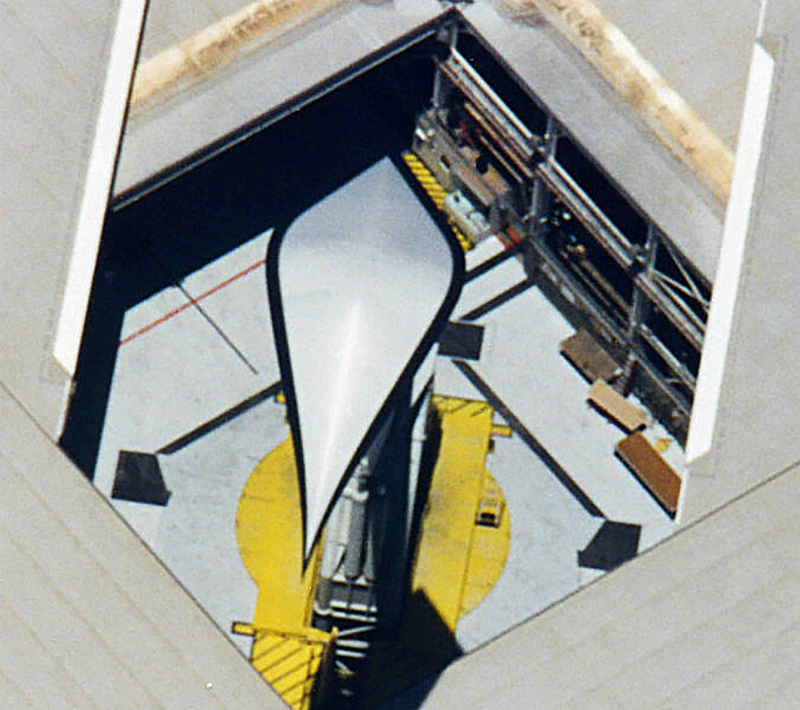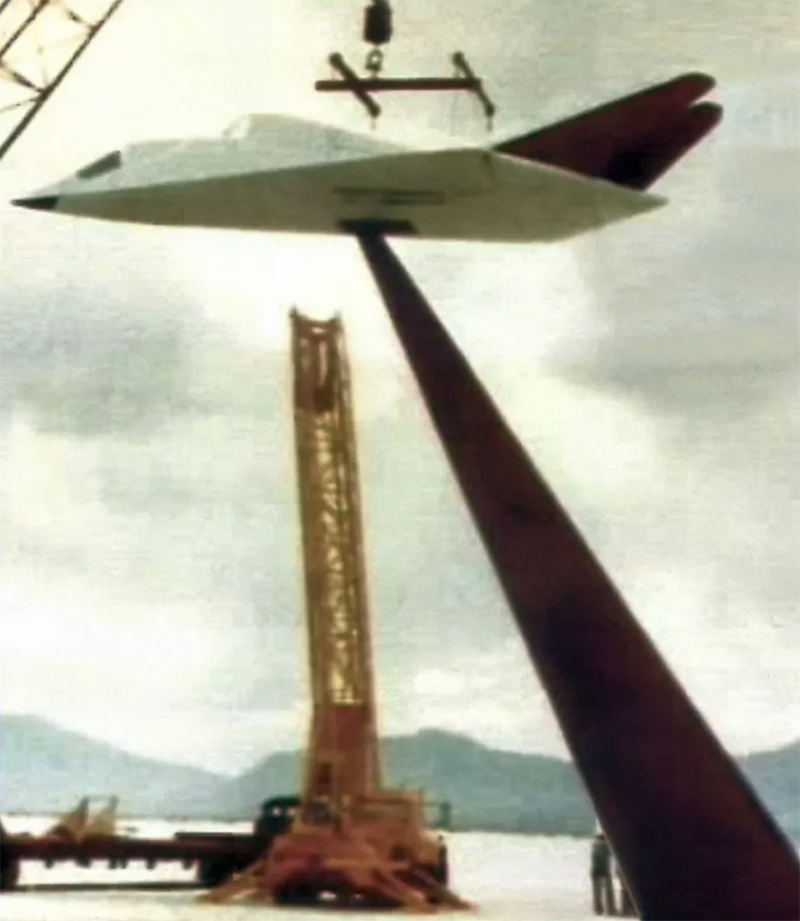Even with the almost surreal size of America's defense budget, most people would be blown away with how many elaborate installations dot the American landscape that are dedicated to the testing and development of new military technologies and weaponry. These include everything from giant sound-stage like buildings used test missile seekers in action, to lakes where new submarine technologies are run through their paces. They also include a number of outdoor radar cross section measurement facilities, commonly known inside the aerospace and defense world as "RCS test ranges."
From Palm Beach, Florida, to Boardman, Oregon, these ranges are often mistaken for clandestine airstrips or have conspiracy theories related to underground bases or even alien technology slapped on them. But their true role is to carefully evaluate the radar signatures of aircraft designs from different aspects and using different radar bandwidths.
Radar signature test sites date back to the dawn of low observable aircraft design, but as the stealth revolution finally got underway in the late 1970s and early 1980s, they became far more technologically advanced than their predecessors.
Their very mission necessitates a large open space with a flat linear area positioned in line with various radar emitters. A pole, or a number of poles, often designed of acute angles or of a radar transparent substance like foam, are used to raise aircraft models high above the ground for testing. Obviously security is a major concern at many of these installations, as testing means putting potentially very sensitive aircraft designs and shapes high-up in the air. As such, these facilities are often located in very desolate and/or pre-secured areas, and feature elaborate security measures and clearly marked borders.

RCS test facilities also usually feature sliding shelters to hide the test article when not being tested, and large hangar-like buildings for storage, not to mention at least one big array of antennas at the opposite end of facility as the test pylon or pylons. Finally, some do feature underground areas which serve the same function as the moving shelter but in a much more functional manner. Mix all these features together and RCS test facilities can look more like a set from Close Encounter of The Third Kind than a place to where radar measurements are taken on model airplanes.
Of all the radar cross section test facilities (aside from the DYCOMS system at Area 51 and the flying NT-43A RAT bird), one of the most elaborate is Lockheed Martin's Helendale RCS measurement facility. Conveniently located in the Mojave Desert, just 45 miles east of Lockheed's Skunk Works headquarters at Plant 42 in Palmdale, California, the installation sits where the old World War II era Helendale Airport once was, on approximately ten square miles of land. In fact, one of the airport's old runways is still in operation for smaller aircraft, like Lockheed's company operated PC-12s that ferry personnel to clandestine sites around the American Southwest, and is lit for nighttime operations. But to be clear, that airstrip is anything but public.
The first phase of the modern Helendale range facility was built in the early 1980s—just as stealth technology was beginning to boom. By that time the Skunk Works' F-117 Nighthawk was already operating in a highly classified manner, flying from deep in the Nevada desert out of Tonopah Test Range Airport and Area 51.
In 1985 the facility saw a major upgrade, which expanded it from a fairly standard two "pit" setup, with the farthest pit being 5,500 feet from the main antenna array, to a three pit layout that measured some 8,200 feet in length. A massive bunker-like concrete installation at the farthest end made up the third and farthest pit, which included a large retractable pole and an underground staging area for lightly modifying, mounting and dismounting test articles. This subterranean hangar like structure is known as the "upper chamber" and is something of a modern marvel in its own right, with its retractable roof and articulating and very stealthy test pole that can be raised high above the pit and retracted far below, deep beneath the upper chamber.

At the other end of the facility, by the main array, a series of hangar, support, and control buildings are present, with the large 70 foot tall dish array sitting at the foot of the perfectly flat concrete slab that continues for roughly 7,500 feet until it terminates at the underground pit. The surface is perfectly smooth, with the natural curvature of the earth negated by design. The facilities various main radar arrays are positioned together, with each being are attached to a hydraulic lift that can position them up or down. Other radar arrays can be placed closer to the poles farther down on the range, and are setup on tracks so that they can be moved in and out of position. Here are some great aerial shots of the facility.
According to the website Otherhand.org, which also has some awesome annotated pictures of the installation, the three pits spaced out along the flat surface are described as such:

The site goes on to describe the interior of the upper chamber space:

So a ton of engineering went into what appears as a fairly sparse but peculiar facility from a distance, and from above. The Pentagon contracted their own iteration of the design around the same time as Helendale was receiving its upgrades in 1985. Known as the Radar Advanced Measurements (RAM) and Radar Target Scatter (RASCAT) facility, it's part of the National Radar Cross Section Test Facility (NRCSTF). The remote installation is located near Holloman AFB, among the White Sands Missile Range. It is the most advanced RCS range in the government's portfolio and features a very similar underground staging facility as the one built at Helendale.
The main NRCSTF, located roughly 35 miles from the RAS/RASCAT facility, is where Northrop and Lockheed had their "pole off" during the XST competition, which ended in Lockheed winning the contract that would eventually give birth to Have Blue and the F-117 Nighthawk. During this early test of stealth design, the radar operator thought Lockheed's "Hopeless Diamond" model fell off the pole until a bird landed on it and a return suddenly showed up on his scope.

You can get an unprecedented look side Lockheed's Helendale RCS range in this video, which includes some very interesting comments from one of the top engineers that runs the site on what has been tested there, and what is possibly flying today under the cloak of deep classification:
With the big changes that have come to rapid prototyping and additive manufacturing, one would have to imagine that building new models and shapes to test at RCS ranges like Helendale has become a faster, cheaper affair for major aerospace companies like Lockheed Martin. It is known that the Skunk Works in particular has taken a very aggressive approach to these capabilities, along with efficiently building large composite structures, dating back to the early 2000s. And considering how potential enemies' radar and integrated air defense system technology is rapidly evolving, being able to better validate and tune new designs to be as stealthy as possible has become more important than ever.
Whereas stealth aircraft like the F-117, and even the F-35 to a large degree, are optimized for low observability in certain radar bands and from certain aspects, next generation stealth aircraft designs, like the B-21 Raider, will feature broadband low observability, which aims to counter a wide number of frequency bands from all aspects. Even morphing aircraft structures will work to reduce an aircraft's detectability by radar in the future. As such, testers at Helendale and other RCS facilities will be more challenged than ever to provide the critical data needed to keep stealth a relevant technology in the coming decades and to validate much more dynamic aircraft designs against multiple radar bandwidths.
But regardless of its capabilities or its critical mission, when it comes to just visuals alone, there are few facilities in the world that look as Hollywood ready as the Helendale RCS range.
Contact the author: [email protected]









